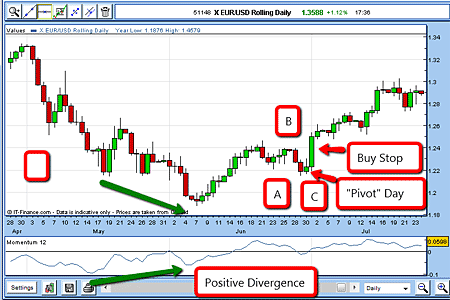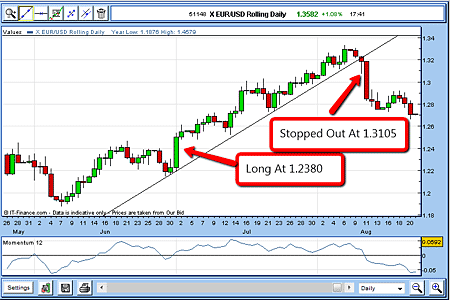Don't let your opinions get in the way of making profits
Our natural human instinct is to flock to those who agree with us. This phenomenon is called 'herding'. And it's precisely where we go wrong as traders and investors.
All of us have gut feelings about our favourite markets sometimes strong ones.
For example, many people, myself included, are convinced that the euro is destined to implode. After all, Greece and Ireland had to be bailed out with huge loans and guarantees (with Germany holding its nose in the process). It's only a matter of time, surely?
When we have a strong view, we tend to read articles backing up our belief. In fact, all we come across are articles and opinions that back our stance. We're drawn to them like moths to a flame.
MoneyWeek
Subscribe to MoneyWeek today and get your first six magazine issues absolutely FREE

Sign up to Money Morning
Don't miss the latest investment and personal finances news, market analysis, plus money-saving tips with our free twice-daily newsletter
Don't miss the latest investment and personal finances news, market analysis, plus money-saving tips with our free twice-daily newsletter
For instance, I like to read the articles and comments on the finance pages of The Daily Telegraph website. Up until June this year, most commentators were extremely bearish. In fact, I couldn't find a single bullish view.
That makes sense. Because our natural human instinct is to flock to those who agree with us. This phenomenon is called 'herding'. And it's precisely where we go wrong as traders and investors.
Joining the crowd can be very expensive in the financial markets. The crowd gets it wrong at major turning points in the market for a very simple reason. When everyone is bullish, there are no potential new buyers left. And when everyone is bearish, there are no new sellers.
This leaves the market vulnerable to small-scale selling (or buying), which now has a magnified effect on price. The move then snowballs as latecomers to the party cut their losses. As traders, these situations are just what we want.
Ignore your prejudices focus on what the charts are telling you
Although I'm long-term bearish on the euro, I know that when my analysis tells me to go long, I should push those thoughts to the back burner, and happily explore the long side.
But at the same time, I always keep a beady eye on the door marked 'Exit'. From experience, I know not to over-stay my welcome in counter-trend trades.
Here's a good example. In June, the euro was hit hard and had few friends. And as I've already noted, that's when a bottom of some sort is usually made. The market rallied to relieve the oversold condition, but at the low (see chart below, indicated with the green arrows), I noted a very large potential 'positive divergence' with momentum.

I was then on the lookout for confirmation of the bottom in other words, I wanted to be sure that the low point had been reached. As the chart shows, the euro rallied against the dollar almost to the end of June. It then pulled back in a clear three-wave Elliott pattern (see points A-B-C).
Now remember a three-wave Elliott pattern signifies a correction in a larger trend. So I was looking for the end of the third wave, so I could get in as the uptrend resumed.
So at point C, I was ready to pay close attention to the action on the following day (the 'pivot day'). If the market was to continue the downtrend, the day would be a down day, and the third wave in the pattern wouldn't have yet completed.
But if it was an up day, that would signal a probable shift back to the upside. So I placed a resting buy-stop order just above the 27 June high (point B) at 1.2400 to catch any possible rally. This order would buy me in if the market hit the required level. And the very next day, the market did indeed surge higher, stopping me in. Using my 3% rule, I placed my protective sell-stop at 1.2260 for a 140 pip maximum risk.
1 July: Long £1 EUR/USD @ 1.2400. Protective Stop @ 1.2260. Risk £140 (2.8%)
Over the next few days, the euro moved higher and jumped above the previous significant high of 1.2460 (hit on 21 June), and then the high of 1.2670 (hit on 27 May). We were definitely in a major move.
That is when I moved my protective stop to break-even, using my break-even rule.
The market's mood can flip very rapidly
Come July, the mood of the market was clearly changing. There was talk of more quantitative easing from the US, while fears over the peripheral eurozone economies were diminishing. Suddenly, the euro was the darling of the traders. From zero to hero in a month or two that's how manic the markets have become.
So even although it went against my bearish long-term beliefs, I decided to ride out the move. I have no hesitation in acting on the technical signals that the market throws at me. After all, the market is the boss, not me.
By late July, I could draw a very clean uptrend line connecting all the minor dips as in the chart:

I moved my protective stops up just below the uptrend line in succession as the new dips were made. I was finally stopped out on 10 August at 1.3105. In all, it was a very clean trade with no major decisions to make along the way.
10 August:Sold £1 EUR/USD @ 1.3105. Profit £705 (Risk £140)
But all along, I was constantly looking for a top in the euro (I was long-term bearish, after all), and the action just after I was stopped out looked very interesting indeed. Time to look for a shorting opportunity.
Get the latest financial news, insights and expert analysis from our award-winning MoneyWeek team, to help you understand what really matters when it comes to your finances.
John is is a British-born lapsed PhD physicist, who previously worked for Nasa on the Mars exploration team. He is a former commodity trading advisor with the US Commodities Futures Trading Commission, and worked in a boutique futures house in California in the 1980s.
He was a partner in one of the first futures newsletter advisory services, based in Washington DC, specialising in pork bellies and currencies. John is primarily a chart-reading trader, having cut his trading teeth in the days before PCs.
As well as his work in the financial world, he has launched, run and sold several 'real' businesses producing 'real' products.
-
 PayPoint: A promising stock for income-seekers
PayPoint: A promising stock for income-seekersPayPoint, a household name across Britain, is moving away from its traditional roots toward a digital future. Investors after a steady income should buy in
-
 Invest in forestry: a tax-efficient way to grow your wealth
Invest in forestry: a tax-efficient way to grow your wealthRecord sums are pouring into forestry funds. It makes sense to join the rush, says David Prosser